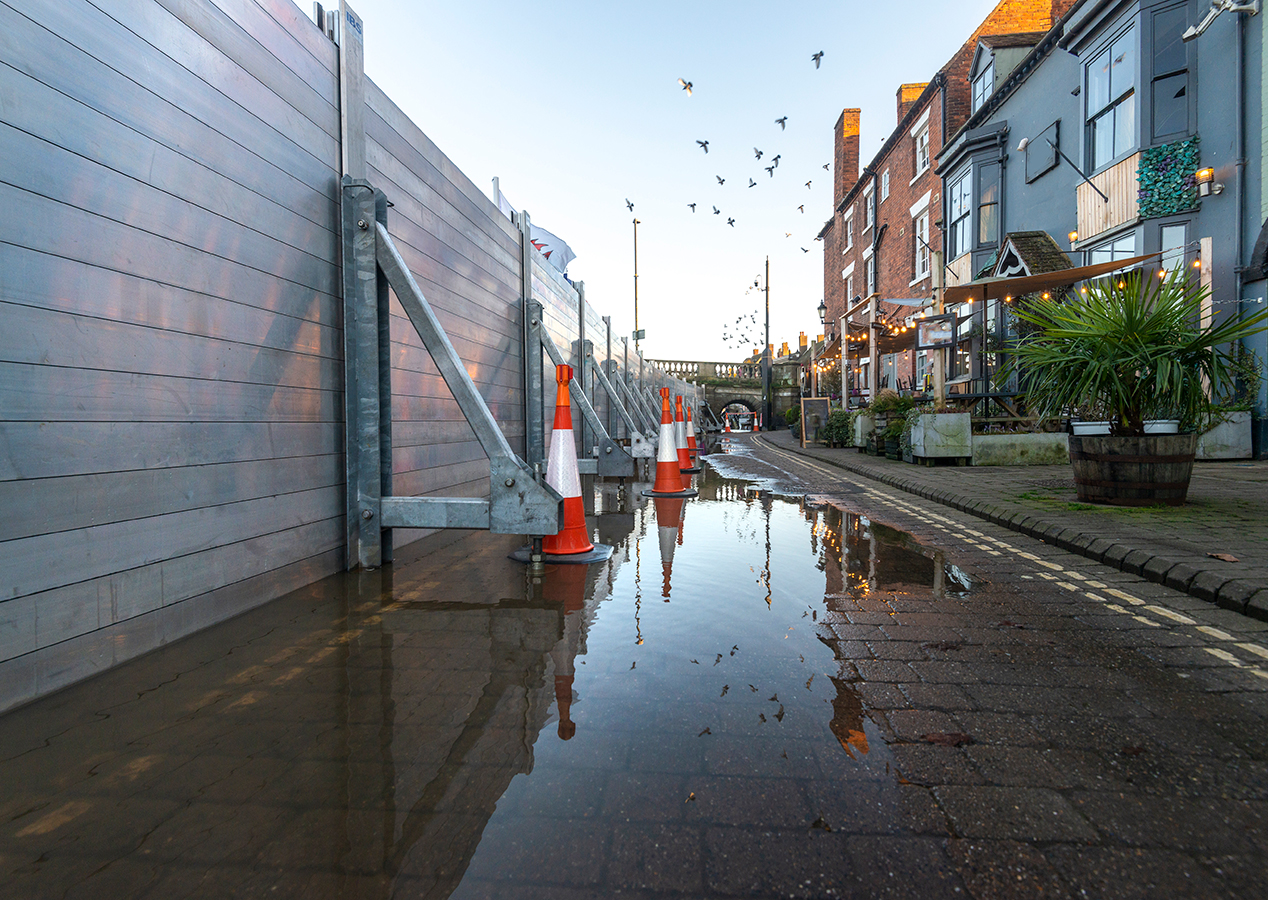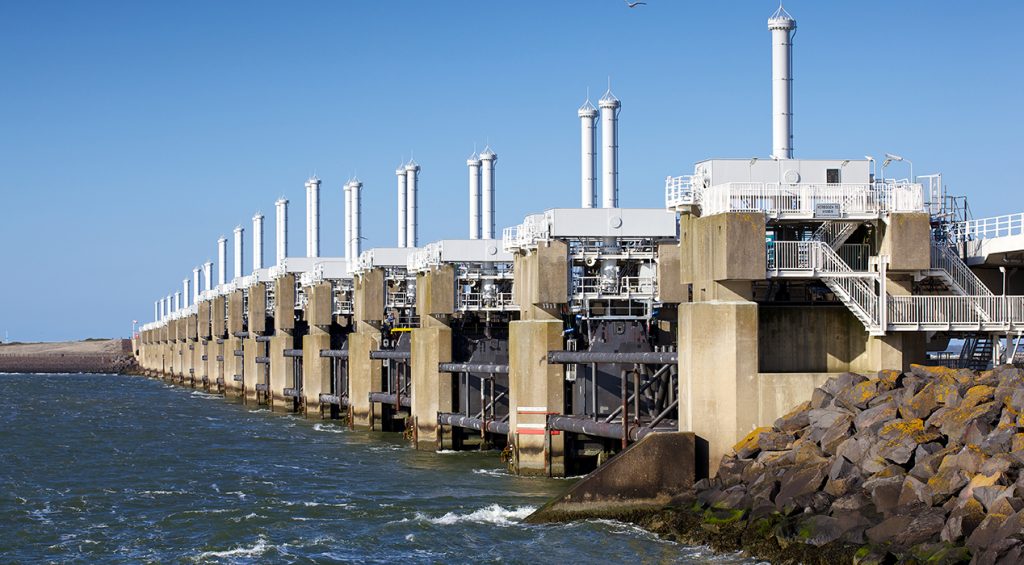Protect Your Property with Flood-Damage Construction Resistant Materials and Methods

If you live, work or operate a business in a flood-prone area, chances are you either have or will face flood conditions. Floods can cause significant damage to people, property and environment. Most standard homeowners and commercial property insurance policies don’t cover water damage from floods, so it’s important to take steps to mitigate this damage.
Flood Damage
Flooding is the overflow of excess water from one or more bodies of water onto adjacent lands. The Federal Emergency Management Agency (FEMA) more specifically defines a flood as “a general and temporary condition of partial or complete inundation of normally dry land areas from (1) the overflow of inland or tidal waters or (2) the unusual and rapid accumulation or runoff of surface waters from any source.
Flooding can damage buildings and their contents in many ways, but most flood damage consists of direct damage during a flood from inundation, high velocity flow, waves, erosion, sedimentation and/or flood-borne debris; degradation of building materials, either during or after the flood; and contamination of the building due to flood-borne substances or mold.
Flood damage can be minimized through design, construction and maintenance practices based on regulations established by the National Flood Insurance Program (NFIP). The NFIP was created by Congress in 1968 to provide federally backed flood insurance in areas where private flood insurance was generally unavailable. In addition, the program identifies flood-prone zones and ensures that new development in these areas is adequately protected from flood damage.
A good construction management
During a flood, buildings can be subjected to hydrostatic (standing water) and hydrodynamic (flowing water) pressures and sustain damage such as displaced foundation walls, collapsed structures, floating fuel tanks and scouring. Flood resistance makes structural and nonstructural components more resistant to flood forces and the deterioration caused by inundation with floodwater.
Classification of Flood Damage-Resistant Materials
NFIP and FEMA regulations describe five classes of flood damage-resistant materials:
- 5: Highly resistant to floodwater damage. Materials within this class are permitted for partially enclosed or outside uses with essentially unmitigated flood exposure.
- 4: Resistant to floodwater damage. Materials within this class may be exposed to and/or submerged in floodwaters in interior spaces and do not require special waterproofing protection.
- 3: Resistant to clean water damage. Materials within this class may be submerged in clean water during periods of intentional flooding.
- 2: Not resistant to water damage. Materials within this class require essentially dry spaces that may be subject to water vapor and slight seepage.
- 1: Not resistant to water damage. Materials within this class require conditions of dryness.
The NFIP judges class 4 and 5 as flood-resistant and class 1, 2 and 3 as not flood-resistant. Therefore, only class 4 and 5 are acceptable for buildings in flood-prone areas below the base flow elevation or BFE. In some instances, class 1, 2 and 3 materials may be permitted below the BFE when specifically required to meet local building code provisions concerning life-safety issues.
Read also: How to create a reliable budget for a commercial and industrial construction project
Flood Damage-Resistant Building Materials and Preconstruction
Building materials that can withstand direct or prolonged contact with floodwater for at least 72 hours without significant damage are considered flood damage-resistant building materials. Significant damage refers to any damage that requires more than low cost, cosmetic repair (such as cleaning, sanding, repainting). The cost of cosmetic repair should not exceed the cost of replacing the affected materials and systems.
Flood damage-resistant materials are commonly used for walls, floors, cabinets, doors and other building parts that are below the (BFE).
Common Flood Damage-Resistant Building Materials
- Reinforced concrete
- Clay, concrete, rubber or steel tiles
- Glazed bricks and glass blocks
- Pressure-treated and marine-treated plywood
- Naturally decay-resistant lumber
- Recycled plastic
- Metal doors and window frames
- Cold-formed steel
- Cement board
- Mastic, silicone, or polyurethane formed-in-place flooring
- Polyester epoxy paint
- Water-resistant glue
- Sprayed polyurethane foam or closed-cell plastic foam insulation
If your property is in a flood hazard area, you can reduce the damage caused by floodwaters and make cleanup easier by using flood damage-resistant building materials.

Floodproofing
Floodproofing is the process of making a building resistant to flood damage, either by taking the building out of contact with floodwaters or by making the building resistant to damage resulting from contact with floodwaters.
Floodproofing can be subdivided into several categories:
- Dry-floodproofing uses special sealants, coatings, components and/or equipment to render the lower portion of a building watertight and substantially impermeable to the passage of water.
- Wet-floodproofing allows the uninhabited lower portion of a building to flood but uses materials that will not be damaged by flooding.
- Active floodproofing, also known as contingent (partial) or emergency (temporary) floodproofing, requires human intervention to implement actions that will protect a building and its contents from flooding. Successful use of this technique requires enough warning time to mobilize people, equipment and floodproofing materials.
- Passive floodproofing, sometimes referred to as permanent floodproofing, involves designing and building structures to be flood proof without human intervention.
Read also: Smart buildings: what they are, how they work and why we are building them
Flood-Resistant Construction Methods
In addition to building with flood damage-resistant materials and floodproofing, additional design and construction methods help reduce the risk of flood damage to property.
- Building structures on stilts or raised foundations to keep them above the flood line.
- Adding flood vents or openings in the foundation or walls that allow water to flow through the structure without causing damage.
- Relocating buildings to higher elevations or away from flood-prone areas.
- Anchoring foundations, fuel and storage tanks, equipment, accessory structures and other components located below the flood protection level to resist flotation, collapse and lateral movement.
- Adding green infrastructure by creating natural landscapes that can absorb and slow down floodwaters.
- Raising electrical, mechanical, HVAC and plumbing system components.
- Installing sewer backflow valves and automatic shutoff valves.
- Protecting wells from contamination.
- Adding waterproof veneer to exterior walls.
For more information about flood-resistant building materials and methods, contact CIC Construction Group.
